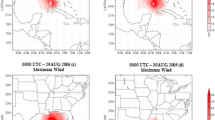Abstract
The advance of fluid dynamics may be divided into four stages: ancient, classical, neoteric, and contemporary. A similar four-stage framework can be used to describe the advance of synoptic meteorology, such as the conceptual models of extratropical cyclones and their attendant fronts. The first conceptual model of extratropical cyclones was proposed by Admiral FitzRoy in 1863. Based purely on Admiral FitzRoy’s personal experience (although it does contain some scientific essentials), this model represents the “ancient” stage of synoptic meteorology. The Norwegian cyclone model was developed based on Newtonian mechanics about 100 yr ago, and represents the classical stage of synoptic meteorology. This model was based on the idea that weather changes are primarily caused by baroclinicity, but contain some serious flaws. In particular, the Norwegian model regards fronts as zeroth-order discontinuities in density, which is inconsistent with the continuity principle of fluid dynamics. The Chicago three-dimensional conceptual model of fronts and cyclones, which was developed approximately 50 yr ago by using quasi-geostrophic theory, can be thought of as representing the neoteric stage of synoptic meteorology. The Chicago model was replaced in the late 20th century by a model of extratropical cyclones characterized by back-bent and wrap-up warm fronts. This model has been developed with massive numerical calculations, and represents the contemporary stage of synoptic meteorology In the era of large data, contemporary synoptic meteorology should be careful to maintain and make full use of the profound physical understanding generated during the neoteric stage of synoptic meteorology.
Similar content being viewed by others
References
Bjerknes, J., and H. Solberg, 1922: Life cycle of cyclones and the polar front theory of atmospheric circulation. Geophysisks Publikationer, 3, 3–18.
Chen Min, Tao Zuyu, Zheng Yongguang, et al., 2007: The front-related vertical circulation occurring in the pre-flooding season in South China and its interaction with MCS. Acta Meteor. Sinica, 65, 785–791. (in Chinese)
Holton, J. R., 1972: An Introduction to Dynamic Meteorology. Academic Press Inc., 45–260.
Li Jiachun, 2011: Flow everywhere. http://bjyouth.ynetcom/3.1/1111/01/6410027.html. Accessed on 1 November 2011. (in Chinese)
Newton, E. C., and E. O. Holopainen, 1990: Extratropi-cal Cyclones—The Erik Palmén Memorial Volume. Amer. Meteor. Soc., Boston, USA, 187–188.
Palmén, E., and C. W. Newton, 1969: Atmospheric Circulation Systems. Academic Press, 60–210.
Petterssen, S., (Translated by Cheng Chunshu), 1958: Weather Analysis and Forecasting. Science Press, Beijing, 138–139. (in Chinese)
Schultz, D. M., and G. Vaughan., 2011: Occluded fronts and the occlusion process—A fresh look at conventional wisdom. Bull. Amer. Meteor. Soc., 92, 443–466.
Shapiro, M., H. Wernli, J. W. Bao, et al., 1999: A planetary-scale to mesoscale perspective of the life cycles of extratropical cyclones: The bridge between theory and observations. The Life Cycles of Extra-tropical Cyclones, Shapiro, M. A., and S. Gronas, Eds., Amer. Meteor. Soc., 139–185.
Snyder, C., C. S. William, and R. A. Rotunno, 1991: Comparison of primitive-equation and semi-geostrophic simulations of baroclinic wave. J. At-mos. Sci., 48, 2179–2194.
Tao Zuyu, Zhou Xiaogang, and Zheng Yongguang, 2012: Theoretical basis of weather forecasting: Quasigeostrophic theory summary and operational applications. Adv. Meteor. Sci. Technol., 2, 6–16. (in Chinese)
Wang, H. Q., K. H. Lao, and W. M. Chan, 1999: A PC based visualization system for coastal ocean and atmospheric modeling. Proceedings of the Sixth International Estuarine and Coastal Modeling Conference, New Orlean, USA, http://envf.ust.hk/cis/doc/4.pdf.
Wang Hongqing, Zhang Yan, Tao Zuyu, et al., 1998: Visualization of large five-dimensional complex data. Prog. Nat. Sci., 8, 742–747. (in Chinese)
—, —, —, et al., 2000: Visualization of the numerical simulation of a Yellow Sea cyclone. J. Appl. Meteor. Sci., 11, 386–387. (in Chinese)
—, —, Zheng Yongguang, et al., 2004: Meteorological data visualization system. Acta Meteor. Sinica, 62, 708–713. (in Chinese)
Xiong Qiufen, Niu Ning, and Zhang Lina, 2013: Analysis of the back-bent warm front structure associated with an explosive extratropical cyclone over land. Acta Meteor. Sinica, 71, 239–249. (in Chinese)
Zhang Wei, Tao Zuyu, Hu Yongyun, et al., 2006: A study on the dry intrusion of air flows from the lower stratosphere in a cyclone development. Acta Sci. Nat. Univ. Pekin., 42, 61–67. (in Chinese)
Author information
Authors and Affiliations
Corresponding author
Additional information
Supported by the China Meteorological Administration Special Public Welfare Research Fund (GYHY201306023). National (Key) Basic Research and Development (973) Program of China (2013CB430106), and National Natural Science Foundation of China (41375051).
Rights and permissions
About this article
Cite this article
Tao, Z., Xiong, Q., Zheng, Y. et al. Overview of advances in synoptic meteorology: Four stages of development in conceptual models of frontal cyclones. J Meteorol Res 28, 849–858 (2014). https://doi.org/10.1007/s13351-014-3297-y
Received:
Accepted:
Published:
Issue Date:
DOI: https://doi.org/10.1007/s13351-014-3297-y




